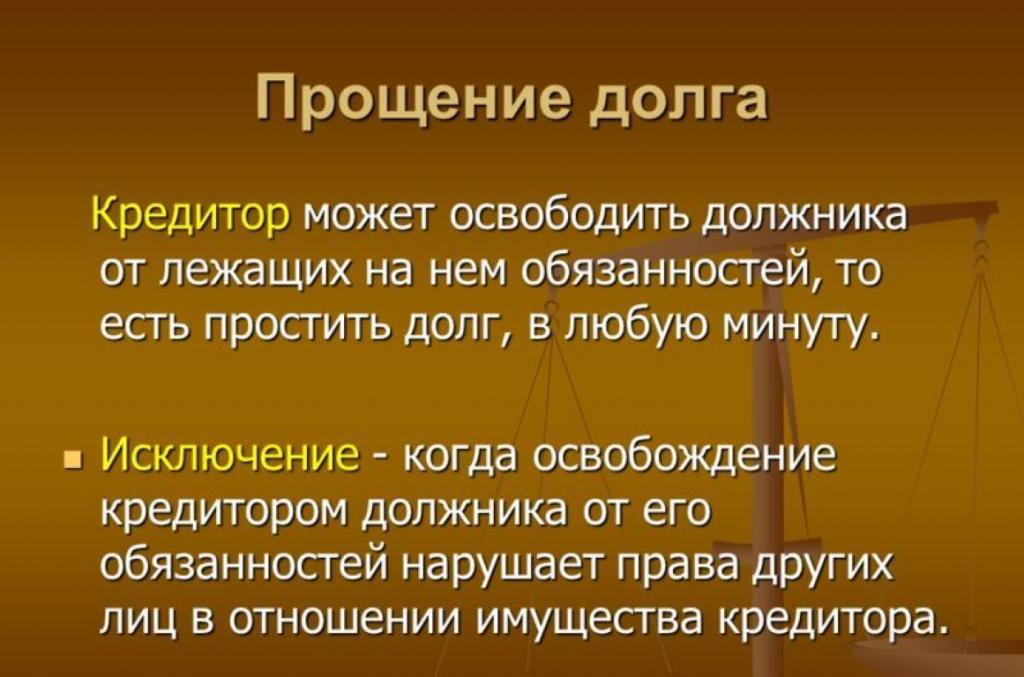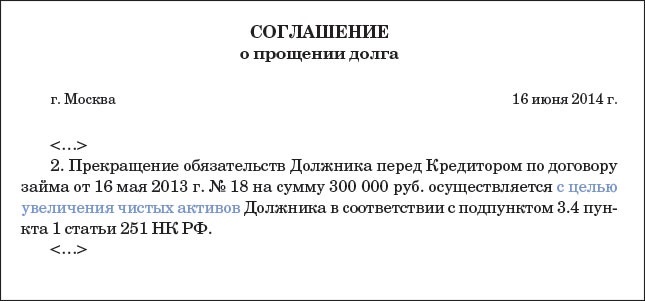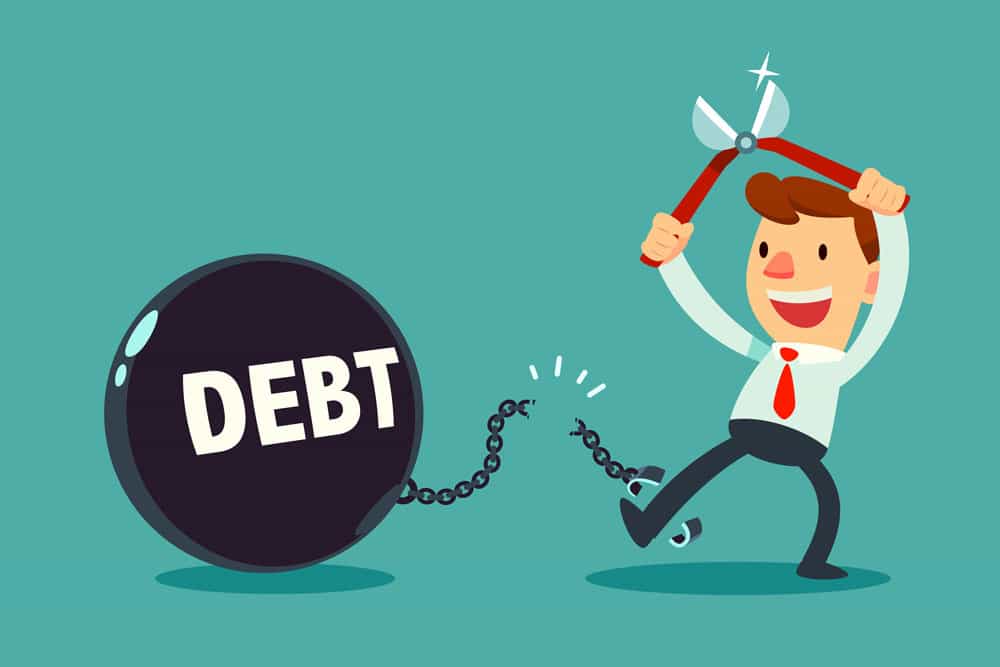Forgiveness of debt is the disposal by the lender of his own debtor of a number of obligations specified in the relevant contract acts.
According to Article 572 of the Federal Civil Code, debt forgiveness is a gift (exemption from property obligations). That is, all procedures for the forgiveness of debt obligations between certain persons in a legal form fit the concept of donation, the framework of which is regulated by Articles 575 and 576 of the Civil Code.
The legislative framework
Art. 415 of the Federal Civil Code:
- The creditor may release the debtor from property obligations, but only if this does not affect the rights of third parties in relation to this property.
- All debt obligations can be considered repaid as soon as the debtor receives the appropriate document in time - a notarized receipt or a simple verbal notice of the termination of the debt obligation.

The law regulates that debt forgiveness, like any other form of donation, can be carried out exclusively at no cost. The holder of the debt does not acquire any material benefit, the debtor is not subject to any obligations. However, the debt forgiveness agreement deprives the creditor of any opportunity to present claims to the debtor to fulfill the original obligations established by the agreement, including demanding this in court. An exception may be considered the adoption of such an agreement void for ten years from the date of signing.
Contract execution
Forgiveness of debt is a formal operation, and therefore, like any other, it takes legal form. Different types of formal termination of debt relations between one or another person are allowed:
- Debt forgiveness is a settlement in a civil process.
- Bilateral transaction between the parties to a debt relationship (debtor and creditor). This is a document that is compiled as an addition to a debt agreement (debt receipt, loan agreement), which contains information on the current legal status of each of the parties in relation to the transaction, the debtor's obligations to the creditor, in case of closing the debt (if any), information about the amount repaid in the agreement (partial or full), as well as an indication that the parties have reached a compromise.
- The creditor may also independently inform the debtor of the absence of debt. Then, if the debtor does not reject the decision in a timely manner, the debt will be declared canceled.
An important (but not key) aspect of a debt forgiveness agreement is the consent of the debtor. It happens both in advance and sequential - depending on the nature of the transaction and property relations between the holder and the lender. At the same time, the debtor has the right to refuse exemption from the debt obligation and continue to fulfill all contractual conditions in the prescribed manner. If, for some reason, the lender refuses to accept a debt obligation, the debtor, in accordance with article 327 of the Civil Code, has the right to pay off his debt by depositing money to a notary account or a court deposit (in some cases).
The creditor himself, wanting to terminate the debt relationship with his debtor, is obliged only to promptly and correctly convey to him information about the withdrawal from him of the obligations established earlier.The debtor, if he agrees with such a decision of the creditor, can send a response letter with consent to repay the debt, and then the document on the forgiveness of the debt will officially enter into force. But if after a certain period from the time when the will of the creditor reached the debtor (this must be confirmed in writing), the latter did not send objections to this decision, and also did not take actions to repay the debt - the transaction will also be considered valid.
Thus, the personal consent of the debtor, although it is an important factor in the execution of documents on debt forgiveness, nevertheless, if there are claims, he should independently send objections to this procedure, since the initiative of the creditor is considered a priority.
Features of the agreement for legal entities
Debt write-off can easily be classified as gift, and according to paragraph 1, paragraph. 4 tbsp. 575 Civil Code, between commercial organizations donated transactions in an amount exceeding 3 thousand rubles are prohibited.
In order for the termination of the debt relationship not to be regarded as grantive, at the time of signing the debt forgiveness agreement, the creditor should definitely confirm the lack of desire to “give” the debtor his refusal of debt obligations and prove the mutually beneficial nature of this transaction.
This can be confirmed by a number of factors:
- it is more profitable for a loan holder to receive a reimbursement of the funds of this debtor for another obligation, therefore he decides to repay one of them ahead of schedule;
- the lender forgives one part of the loan to guarantee the return of the rest of the debt, not wanting to file a lawsuit - this is partial debt forgiveness, agreements of this type are most often found;
- the lender forgives the debt as an economic subsidiary;
- in other cases in which the forgiveness agreement meets the criteria for a paid operation.
Despite the fact that modern federal legislation does not directly prohibit the implementation of such agreements orally, formalization of all aspects of this procedure will make it possible to exclude the occurrence of any legal problems. All relevant documentation should be provided to the parties in electronic and printed form.
The sample debt forgiveness agreement posted below will help you better understand which document is in question.

Also, in addition to the contract or the receipt on termination of debt obligations, the lender and the debtor draw up a reconciliation document for mutual settlements. It should determine the reasons for the appearance of debt obligations, confirmation of their presence and formal relationships, according to which there was an obligation to repay the debt. Without this document, an agreement may be deemed invalid.
Forgiveness Agreement between Individuals
One individual can at any time forgive a debt to another, and in the legal field this will be classified simply as a gift. In this regard, individuals have much less restrictions, compared with legal entities.

Forgiveness of debts by a company to an individual
Any organization that owns profit, by definition, seeks to implement a mutually beneficial transaction, therefore, it is believed that simply "writing off" the debt to an individual for a legal lender is not possible. However, unlike the relationship between legal entities, the relationship between a legal entity and an individual is not subject to such severe restrictions from the federal legislation. In addition, many organizations themselves practice debt relief for their employees as part of their corporate policies. For example, part of the debt is written off if the employee has already paid off one share and will work in this company for a certain time. Then an agreement is concluded on partial debt forgiveness.The company may also make concessions if the employee is in an extremely difficult financial situation.
An agreement on the forgiveness of part of a debt is best executed in writing, indicating all the important points.

There are several ways to support such an employee:
- The simplest form of procedure is simply to send a message from the employer to the employee’s place of residence and notify him of the debt closure.
- The ability to write off debt may be indicated when drawing up a loan contract.
- In this case, an auxiliary agreement is drawn up, attached to the main contract, which will indicate all the criteria under which it will enter into force. A separate document on writing off debts to a specific individual can be drawn up.
- You can also draw up a deed of gift.

Forgiveness of debts to the founder under a loan agreement
If the company previously gave the founder interest-free loans, he has the right not to return the funds if the company forgives him the debt. To do this, you must conclude a loan debt forgiveness agreement (in any form). Nevertheless, this does not cancel the obligations of the founder to the enterprise.
The sample agreement of the debt forgiveness by the founder, posted below, will allow you to clearly see what kind of document in question.

Tax consequences
When writing off a debt on a loan by an enterprise, a certain financial gain appears, equivalent to the forgiven amount. This will certainly attract the tax service, because in the Tax Code of the Russian Federation there is no concept of “debt forgiveness”. In these conditions, the company must pay the appropriate amount of personal income tax to the state budget. Calculate the tax should be based on a fixed rate of 13%.
If for some reason the deduction of the necessary amount of personal income tax is not feasible, the organization must not later than 1 month from the end of the tax period during which these conditions appeared (until February 1 of the year following the year when the debt was forgiven), inform the employee of the fiscal service in writing about the impossibility of withholding tax, as well as indicate its amount, in accordance with form 2-NDFL.

Conclusion
Amnesty of debt, as a rule, expresses exclusively the good will of the creditor and can cause some economic damage to both parties to the legal relationship. The laws of the Russian Federation do not fully regulate this issue, especially in terms of taxes, so many problems that arise in practice are accepted by them at their own peril and risk.
